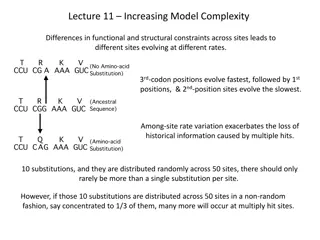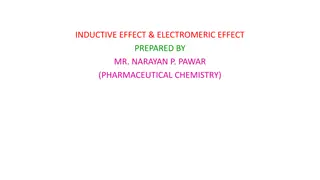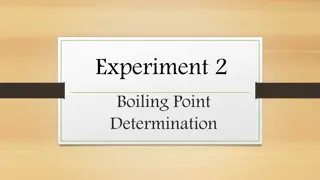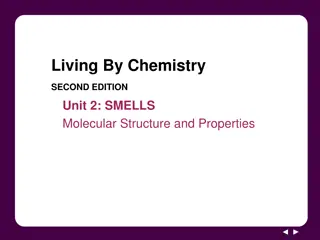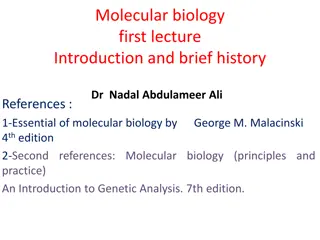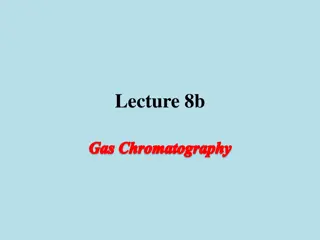Asia-Pacific Molecular Diagnostics Market
Asia-Pacific Molecular Diagnostics Market\nAsia-Pacific Molecular Diagnostics Market by Product & Service (Kits, Instruments) Test Type (Lab, PoC) Technology (PCR, ISH, Sequencing, INAAT, Microarray) Application (Infectious Diseases, Oncology) End User (Hospitals, Diagnostic Lab)
0 views • 3 slides
Understanding Polarity and Oil Spill Impacts
Explore the concept of polarity in molecules and its impact on interactions, learn about the environmental effects of oil spills, and understand methods used for oil spill cleanup. Discover how polar and nonpolar molecules behave differently and the challenges posed by oil spills on wildlife and eco
2 views • 13 slides
Understanding Molecular Dynamics: Insights from Across Scales
Exploring molecular dynamics from molecules to pandemics, this presentation delves into the intricate energy landscapes of molecular systems, sampling problems, advanced techniques, and analysis of simulations to uncover valuable insights crucial for various scientific disciplines like drug discover
5 views • 21 slides
Understanding Molecular Docking in Bioinformatics
Explore the world of molecular docking in bioinformatics through in silico approaches, learning about protein-ligand interactions, modes of docking, different docking approaches, and the theory of enzymes. Discover how this computational method helps predict the binding affinity and conformation of
4 views • 41 slides
Evolutionary Models in Molecular Biology
Differences in functional and structural constraints across sites lead to varying rates of evolution in molecular sequences. Understanding the complexities of site-specific rates, among-site rate variation, site-specific rates models, invariable sites model, and continuous methods is crucial for acc
6 views • 15 slides
Great Power Rivalry in World Politics: Understanding Polarity, Balance of Power, and Hegemonic Transition
Great power rivalry involves deep competition and hostility between major players like the US, China, and Russia. The concept is explored through polarity, balance of power, and hegemonic transition theories, discussing power distribution, strategies, and transitions in the international system. The
4 views • 12 slides
Unsaturated Hydrocarbons Alkynes
Chapter three delves into the world of alkynes, focusing on their structure, hybridization, bonding, nomenclature, physical properties, preparation, and reactions. Alkynes are hydrocarbons with at least one triple bond, forming a homologous series with the molecular formula CnH2n-2. The sp hybridiza
0 views • 20 slides
Understanding the Inductive and Electromeric Effects in Organic Chemistry
The inductive effect in organic chemistry is the polarization of a bond due to electron-donating or withdrawing effects of adjacent groups, leading to a degree of polarity in the bond. This effect is distance-dependent and can be either electron-withdrawing or electron-releasing. On the other hand,
0 views • 12 slides
History of Molecular Biology: Key Experiments and Discoveries
This content covers the introduction and brief history of molecular biology, highlighting key experiments such as the work of Freidrich Miescher, Griffith's transformation experiment, and Avery-MacLeod-McCarty's proof of DNA as the genetic material. It explores the early understanding of macromolecu
1 views • 17 slides
Genetics and Molecular Biology Lecture Series by Dr. Madan K. Bhattacharyya
Explore a comprehensive lecture series covering Genetics, Molecular Genetics, and Recent Advances in Plant Breeding by expert Dr. Madan K. Bhattacharyya. Delve into topics such as gene structure, transcription, translation, and the central dogma of molecular biology through informative visuals and v
2 views • 46 slides
Understanding Boiling Point Determination in Chemistry
Boiling point is the temperature at which a substance changes from a liquid to a gas phase, influenced by factors like molecular weight, polarity, branching, and impurities. This crucial property is used for substance identification and purity checks. The experimental process involves precise handli
1 views • 9 slides
Exploring Supramolecular Chemistry: Insights and Applications
Supramolecular chemistry delves into the chemistry of molecular assemblies, intermolecular bonds, and non-covalent interactions, leading to the formation of supra-molecules through aggregation of molecular subunits. Concepts like molecular recognition, self-organization, and host-guest chemistry pla
0 views • 18 slides
Understanding Infrared Spectroscopy and Molecular Vibrations
Exploring the fascinating world of infrared spectroscopy and molecular vibrations. Learn about the different regions of the infrared spectrum, Hooke's law, vibrational frequencies, and the types of molecular vibrations. Discover how bond strength, reduced mass, and wave numbers are interconnected in
0 views • 18 slides
Comprehensive Overview of Molecular Diagnostics, Cytogenetics, and Forensic Biology
Explore a detailed curriculum covering molecular diagnostics, traditional disease diagnosis methods, genetic disorders, cytogenetics, molecular techniques, biochemical tests, PCR applications, immunoassays, and forensic biology including microbial forensics, entomology, botany, serology. Lectures co
1 views • 4 slides
PCR and Blot Techniques in Molecular Biology
Polymerase Chain Reaction (PCR) is a crucial technique for amplifying specific DNA segments rapidly and accurately. Developed in 1983, PCR is widely used in various fields such as molecular biology, forensics, evolution, and medical diagnostics. On the other hand, the Blot technique transfers DNA, R
0 views • 10 slides
Understanding Gene Mutations in Molecular Biology
Gene mutations play a significant role in molecular biology, leading to alterations in DNA sequences that can impact offspring. These mutations can arise spontaneously or be induced by various factors, such as mutagens. Understanding gene mutations is crucial for comprehending the genetic basis of c
2 views • 27 slides
Understand Molecular Structures with Lewis Dot Symbols
Explore the world of molecular structures with Lewis dot symbols in this chemistry unit. Learn about valence electrons, covalent bonding, and the HONC 1234 rule through engaging activities and discussions. Create accurate structural formulas and describe bonding in molecular substances. Get ready to
0 views • 13 slides
Kinetic Molecular Theory and States of Matter in Physical Pharmacy
The lecture by Assistant Prof. Dr. Fouadalssady in physical pharmacy delves into the Kinetic Molecular Theory, elucidating how gases consist of particles in constant motion with negligible volume. It explains the relationship between kinetic energy, temperature, and the transition from gas to liquid
0 views • 10 slides
Breast Cancer Survival Disparities by Molecular Subtypes in the US
Breast cancer molecular subtypes play a crucial role in determining survival outcomes. This study by Nadia Howlader, PhD, from the National Cancer Institute, presented the first nationally representative estimates of breast cancer survival by four main molecular subtypes. The research aimed to under
1 views • 23 slides
Understanding Organic Chemistry: Carbon Atoms and Molecular Diversity
In organic chemistry, carbon atoms can form diverse molecules by bonding to four other atoms, leading to molecular complexity and diversity. The versatile nature of carbon allows for the formation of various carbon skeletons, contributing to the vast array of organic compounds. Hydrocarbons, consist
0 views • 12 slides
Introduction to Molecular Biology: Historical Insights and Key Experiments
Molecular biology is a field that focuses on understanding the behaviors of macromolecules like DNA, RNA, and proteins. This summary discusses the history of molecular biology, including the work of Friedrich Miescher and Griffith's experiment, which demonstrated the transfer of genetic material. Th
0 views • 19 slides
Unveiling Polarity with Polarity-Inducing Latent Semantic Analysis
Polarity-Inducing Latent Semantic Analysis (PILSA) introduces a novel vector space model that distinguishes antonyms from synonyms. By encoding polarity information, synonyms cluster closely while antonyms are positioned at opposite ends of a unit sphere. Existing models struggle with finer distinct
1 views • 29 slides
Understanding Potato Photosynthesis: Molecular Models and Chemical Changes
Explore the process of photosynthesis in potato plants through molecular models and chemical changes at different scales, from atomic-molecular to macroscopic. Learn how potato plants produce food through biosynthesis and cellular respiration, connecting the atomic-molecular scale to the macroscopic
0 views • 23 slides
Understanding Molecular Vibrations in Vibrational Spectroscopy
Explore the world of molecular vibrations and their significance in vibrational spectroscopy. Learn about the different types of vibrations in diatomic and triatomic molecules, the concept of degrees of freedom, and how atoms change positions to create varying bond lengths and angles. Discover the r
0 views • 47 slides
Lewis Dot Structures and Polarity Review
Learn about Lewis dot structures, how to draw them, determine polarity, and practice drawing various compounds. Understand the concepts of valence electrons, central atoms, bonding, and lone pairs in molecules. Discover the distinction between polar and nonpolar structures based on symmetry.
0 views • 10 slides
Understanding Molecular Polarity and Electronegativity in Chemistry
Explore the concept of molecular polarity, electronegativity, and bonding in chemistry through engaging visuals and discussions. Learn how the unequal sharing of electrons between atoms leads to polarity in molecules and discover the role of electronegativity in attracting shared electrons. Delve in
0 views • 12 slides
Understanding Polarity in Covalent Bonds
The difference between a polar molecule and a nonpolar molecule lies in the distribution of electrons. A polar molecule has an asymmetric electron distribution due to a significant difference in electronegativity, while a nonpolar molecule has a symmetric electron distribution. You can predict polar
0 views • 15 slides
Understanding Solubility, Polarity, and Cleaning in Chemistry
Explore the concepts of solubility in different solvents, the role of polarity in dissolving compounds, and how cleaning agents work based on their polar or nonpolar nature. Discover how soap molecules form micelles to remove stains effectively, and learn about emulsions like mayonnaise where oil an
0 views • 18 slides
Understanding Polarity, Electronegativity, and Chemical Bonds
Delve into the concepts of polarity, electronegativity, and different types of chemical bonds by exploring the tug-of-war analogy and examples of polar, nonpolar, ionic, and covalent bonds. Learn how electronegativity values determine the nature of bonds and the sharing of electrons in molecules.
0 views • 17 slides
Understanding Smells Through Molecular Structure: A Lesson in Polarity
Delve into the realm of molecular structure and properties to explore the intriguing link between polarity and smell. Discover why some compounds like hydrogen chloride and ammonia have distinct scents, while others like oxygen and methane remain odorless. Uncover the role of polarity in determining
0 views • 15 slides
Exploring Molecular Biology and Cell Science
Molecular biology delves into the study of biology at the molecular level, focusing on gene structure and functions to comprehend hereditary traits, genetic variation, and gene expression patterns. Cells, the fundamental units of life, vary in shape and function but share basic structures. The Three
0 views • 31 slides
Understanding the Influence of Molecular Weight on Polymer Flow Behavior
Molecular weight plays a critical role in determining the flow behavior of polymers above their glass transition temperature or melting point. The zero shear viscosity of polymers is directly related to their molecular weight, with significant changes in viscosity observed even with small difference
0 views • 13 slides
Role of Solvent in Spectral Properties and Solvatochromism
Solvent plays a crucial role in physical and chemical processes, affecting kinetics, equilibria, and spectral properties such as UV-vis, IR, and NMR. Solvathochromism describes the change in spectral bands caused by solvent interactions. Factors like solvent polarity and hydrogen bonding influence d
0 views • 19 slides
Understanding Smell and Molecules in Chemistry
Explore the relationship between molecular structure and smell in chemistry through concepts of polarity, phase, and size. Learn how different molecules evoke scents and why some substances have distinctive smells while others do not. Dive into discussions on volatile molecular solids, aromatic comp
0 views • 13 slides
The American Society for Biochemistry and Molecular Biology - Advancing Research in Life Sciences
Founded in 1906, the American Society for Biochemistry and Molecular Biology (ASBMB) is a prominent organization that explores the fundamental chemistry of life and intricate interactions among biological molecules. ASBMB publishes prestigious research journals covering various fields such as microb
0 views • 5 slides
Understanding Gas Chromatography: Basics, Theory, and Applications
Gas chromatography is a powerful analytical technique widely used in research, industrial quality control, forensics, and environmental analysis. This method separates compounds in a mixture based on polarity, boiling point, and interactions with the stationary phase. The setup includes components l
0 views • 10 slides
Understanding Non-Covalent Pi-System Interactions in Molecular Structures
Non-covalent interactions play a crucial role in chemical selectivity and molecular recognition. This article discusses the significance of Pi-system interactions, including Pi-Pi and Cation-Pi interactions, in stabilizing molecular structures like DNA helices and G-quadruplexes. Insights into molec
0 views • 6 slides
Polymer Molecular Weight Exercise Analysis
This exercise involves calculating the number average and weight average molecular weights, as well as the polydispersity index (PDI) for a sample of polystyrene composed of fractions with different molecular weights. The analysis includes determining the number of moles in each fraction, calculatin
0 views • 7 slides
Anytime Weighted MaxSAT with Improved Polarity Selection and Bit-Vector Optimization
Weighted MaxSAT is a optimization problem where targets are assigned weights and hard clauses must be satisfied. The goal is to find a model that maximizes the overall weight of satisfied target bits. The formulation involves unit clauses associated with integer weights, with a focus on improving po
0 views • 49 slides
New Global Economic Governance and Currency Multi-Polarity: The Changing Landscape
The world is undergoing radical transformations in economic governance and currency dynamics, signifying the end of old orders. Academic perspectives vary on the current state of global affairs, with discussions on an unsettled order and upheavals in power relations. Pervasive reforms within G7, G20
0 views • 18 slides




